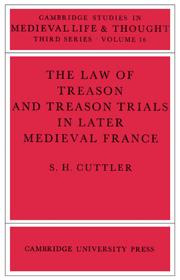Book contents
- Frontmatter
- Contents
- Dedication
- Preface
- Abbreviations
- Introduction
- 1 THE CONCEPT OF TREASON IN LATER MEDIEVAL FRANCE: LEGISTS, ‘COUTUMIERS’ AND TREATISE-WRITERS
- 2 THE CRIMES OF TREASON
- 3 JURISDICTION
- 4 PROCEDURE AND THE TRIAL OF PEERS
- 5 PUNISHMENT, FORFEITURE AND PARDON
- 6 TREASON AND THE CROWN 1328–1356
- 7 TREASON AND THE CROWN 1356–1380
- 8 TREASON AND THE CROWN 1380–1422
- 9 TREASON AND THE CROWN 1422–1461
- 10 TREASON AND THE CROWN 1461–1494
- Conclusion
- Bibliography
- Index
6 - TREASON AND THE CROWN 1328–1356
Published online by Cambridge University Press: 13 October 2009
- Frontmatter
- Contents
- Dedication
- Preface
- Abbreviations
- Introduction
- 1 THE CONCEPT OF TREASON IN LATER MEDIEVAL FRANCE: LEGISTS, ‘COUTUMIERS’ AND TREATISE-WRITERS
- 2 THE CRIMES OF TREASON
- 3 JURISDICTION
- 4 PROCEDURE AND THE TRIAL OF PEERS
- 5 PUNISHMENT, FORFEITURE AND PARDON
- 6 TREASON AND THE CROWN 1328–1356
- 7 TREASON AND THE CROWN 1356–1380
- 8 TREASON AND THE CROWN 1380–1422
- 9 TREASON AND THE CROWN 1422–1461
- 10 TREASON AND THE CROWN 1461–1494
- Conclusion
- Bibliography
- Index
Summary
Thus far we have examined the theoretical framework of the law of treason, the range of crimes encompassed by that law, the administrative and legal aspects of enforcing the law, the legal and political problems raised by the trials of peers and clerics, and the principal features of forfeitures and reversals. In the next five chapters we shall leave the descriptive and analytical paths in order to consider chronologically the prosecution of treason in later medieval France. For the extent and nature of the crown's response to treason can shed some light not only on the political relations generally between crown and nobility, but also perhaps on the characters and policies of individual kings.
The last Capetian kings of France did not on the whole prosecute rebellion and treason with severity. The revolts of the counts of Foix and Armagnac in the early 1270s, and that of the vicomte of Narbonne in the early 1280s, for example, were dealt with easily and leniently. It is true that the trials of Bernard Saisset in 1301 and the count of Flanders in 1312 were indicative of a more aggressive royal policy on treason, particularly in Guyenne; but however important these trials were in their jurisdictional and procedural aspects, and whatever Philippe IV's true intentions were, one cannot say that his treatment of either the bishop or the count was brutal. Indeed, the only known executions for treason during Philippe IV's reign were those in 1305 of the eight consuls and some other inhabitants of Carcassonne, and of about forty people from Limoux, all of whom were implicated in a conspiracy to renounce the sovereignty of France in order to escape the rigours of the Inquisition.
- Type
- Chapter
- Information
- The Law of Treason and Treason Trials in Later Medieval France , pp. 142 - 162Publisher: Cambridge University PressPrint publication year: 1982



